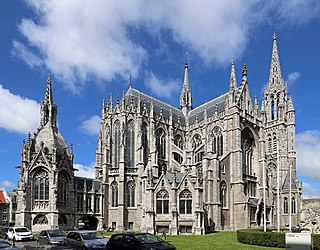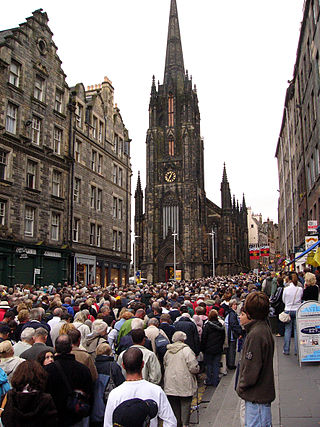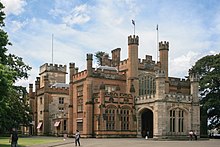
Augustus Welby Northmore Pugin was an English architect, designer, artist and critic with French and Swiss origins. He is principally remembered for his pioneering role in the Gothic Revival style of architecture. His work culminated in designing the interior of the Palace of Westminster in Westminster, London, and its iconic clock tower, later renamed the Elizabeth Tower, which houses the bell known as Big Ben. Pugin designed many churches in England, and some in Ireland and Australia. He was the son of Auguste Pugin, and the father of Edward Welby Pugin and Peter Paul Pugin, who continued his architectural firm as Pugin & Pugin.

Gothic Revival is an architectural movement that after a gradual build-up beginning in the second half of the 17th century became a widespread movement in the first half of the 19th century, mostly in England. Increasingly serious and learned admirers sought to revive medieval Gothic architecture, intending to complement or even supersede the neoclassical styles prevalent at the time. Gothic Revival draws upon features of medieval examples, including decorative patterns, finials, lancet windows, and hood moulds. By the middle of the 19th century, Gothic Revival had become the preeminent architectural style in the Western world, only to begin to fall out of fashion in the 1880s and early 1890s.
The year 1902 in architecture involved some significant events.
The year 1859 in architecture involved some significant architectural events and new buildings.
The year 1856 in architecture involved some significant architectural events and new buildings.
The year 1844 in architecture involved some significant architectural events and new buildings.
The year 1839 in architecture involved some significant architectural events and new buildings.
The year 1887 in architecture involved some significant architectural events and new buildings.
The year 1851 in architecture involved some significant architectural events and new buildings.
The year 1835 in architecture involved some significant architectural events and new buildings.
The year 1852 in architecture involved some significant architectural events and new buildings.
The year 1812 in architecture involved some significant events.
The year 1855 in architecture involved some significant architectural events and new buildings.
The year 1847 in architecture involved some significant architectural events and new buildings.
The year 1832 in architecture involved some significant architectural events and new buildings.

The Hub is a public arts and events building in the centre of Edinburgh, Scotland. Located at the top of the Royal Mile, it is a prominent landmark as its tall Gothic spire is the highest point in central Edinburgh, and towers over the surrounding buildings below Edinburgh Castle.
The year 1831 in architecture involved some significant events.
The year 1916 in architecture involved some significant events.
Events from the year 1844 in the United Kingdom.

John Norton was an English architect who designed country houses, churches and a number of commercial buildings.





